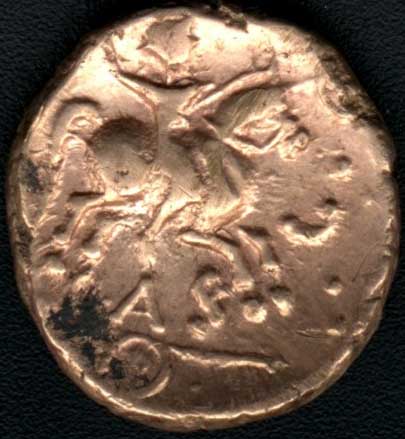Finding, Buying and Collecting Celtic Coins - Introduction
Finding, Buying and Collecting Celtic Coins - Introduction
The Earliest Celtic Coins
The Celts started minting coins in the late 4th century BC. These early Celtic coins were imitations of the coins of Philip II of Macedon and his son, Alexander the Great. Celtic imitations of Greek coins often contain pictures of Greek rulers, gods and even Greek text.

Above: Gaulish Celtic Imitation of a gold Stater of Philip II of Macedon. Photograph by Marie-Lan Nguyen.
As time passed, the Greek designs on early Celtic coins 'degraded', becoming increasingly more abstract. Why this happened is not clear. Were the Celtic engravers, who made the dies for the coins, cut off from their supply of Greek coins and resorted to trying to copy coins from memory? Did the Celts lose the skills to copy Greek coins so beautifully over several generations? Or did the Celts decide that they wanted to make their own mark on the designs and make them their own? We will probably never know.
Celtic Coins in Britain
Celtic coins were minted in Britain from the late second century BC until the eventual Roman take over in the middle of the first century AD. The first Celtic coins to arrive in Britain would have been the imitations of the coins of Philip II mentioned above, but as far as we know those were all imported from the continent and not actually made here.
The first 'made in Britain' Celtic coins are thought to have been the Thurrock Potins. These crude cast coins seem to originate in Kent and were imitations of Potins made by tribes in Gaul. It is possible that these first British Celtic coins were made by Gaulish settlers in Kent, the Celtic peoples of Kent would certainly have had very close ties to the continent.

Above: A Gaulish Potin, similar to the ones copied by the makers of the Thurrock Potins. Photograph by Gblerot.
The First British Gold Staters
The first British Gold Staters were copies of the continental Gallo-Belgic bi-face staters. The most common of these British imitations are the Chute and Westerham Staters.
Dynastic Celtic Coins
The most beautiful, and probably the most collected, Celtic coins are the dynastic issues of the north Thames tribes. Minted between 35BC and 43AD, the dynastic issues of the north Thames Tribes often display the names of the two best known rulers of this time period, Tasciovanus (meaning 'Badger Killer', or 'Killer of Badgers') and Cunobelin, (meaning 'hound of Belinus', Belinus being a Celtic sun god) Shakespeare's Cymbeline.
Tasciovanus often abbreviated his name on coinage to 'Tascio' or 'TASC' and Cunobelin to 'CVNO' or 'CVN' (not to be confused with 'CAMV', an abbreviation of 'Camulodunum', meaning 'the Fortress of Camulos', a place we know today as Colchester. The appearance of CAMV on the coins of the north Thames tribes is a mint mark, not the name of a ruler).

Other names appear on the coins of the north Thames tribes, such as Addedomarus, who may have been Tasciovanus' older brother. The identities of some of the other rulers named on the coins of the north Thames tribes, such as ANDOCO, DIAS and SEGO, are lost to the mists of time, but they were almost certainly members of Tasciovanus' family or regional war lords loyal to him.
The Celtic Coin Index
The Celtic Coin Index (CCI) is a project run by Dr. Philip de Jersey at the Institute of Archaeology, Oxford University. The project aims to identify, record and log the find spots of every Celtic coin found in Britain. The CCI database currently contain records of more than 37,000 Celtic coins. Every metal detectorist lucky enough to find a Celtic coin should ensure that their find is logged at the Celtic Coin Index.
Celtic Coin Resources
- Celtic Coinage of Britain by Robert Van Arsdell (Free Online Edition). An important work of reference on Iron age coins. Very handy for identifying your celtic coin finds!
- Chris Rudd Celtic Coins
See also
- Chris Rudd releases Celtic coin book
- Coinage of the Ancient Britons. Article from From The Mirror of Literature, Amusement, and Instruction, No. 358 Vol. XIII, No. 358., Saturday, February 28, 1829
